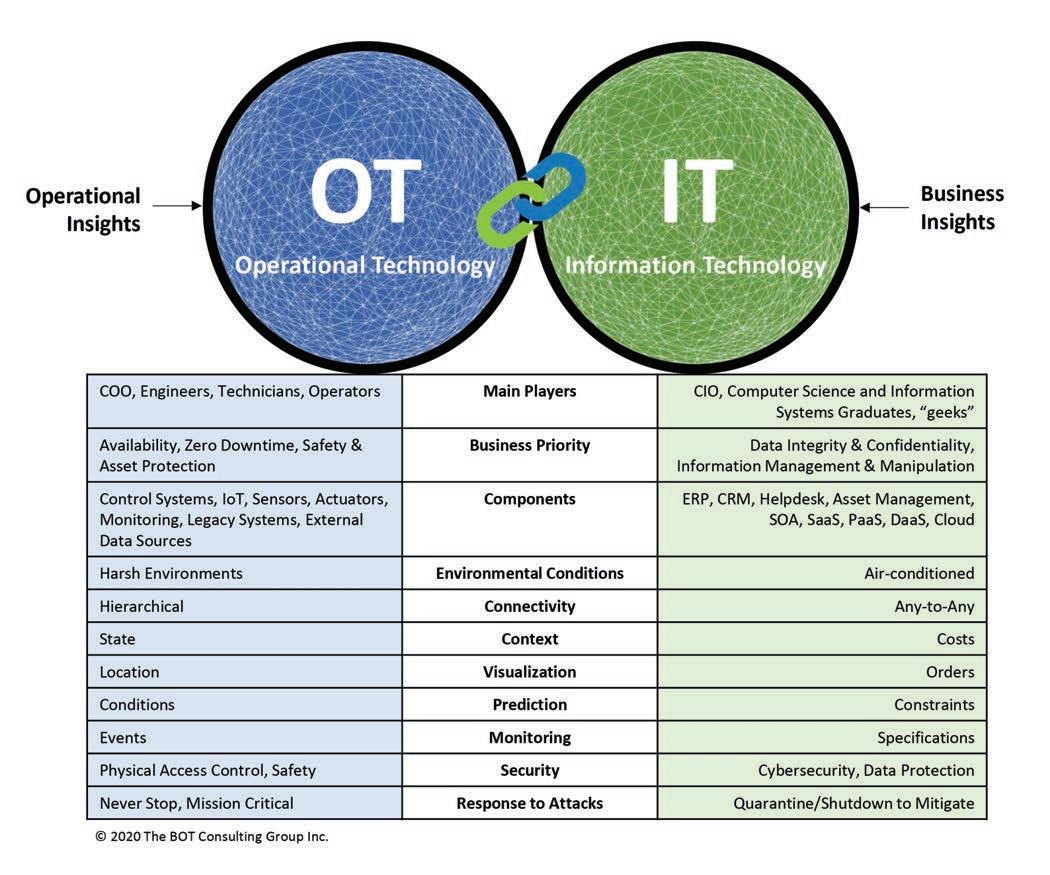
13 minute read
OT–IT Convergence
AN IMPERATIVE FOR INDUSTRY 4.0
BY SONIA D. BOT
Industry 4.0 (also known as the Fourth Industrial Revolution) was formalized by the World Economic Forum in 2016. Industry 4.0 uses automation and data exchange in processes and technologies that include IIoT (Industrial Internet of Things), cloud computing, and AI (artificial intelligence) for implementation.
Corporations worldwide, including railroads and their partners in the transportation supply chain, are at the beginning of their journey for establishing true end-to-end digital continuity. Railroading is embarking in IIoT (for example, Positive Train Control, Enhanced Train Control) and automation (for example, autonomous track inspection), through to AI-based automation (for example, expanding autonomous track inspection to include predictive analytics for track data). The convergence of OT (Operational Technology) and IT (Information Technology) is essential for Industry 4.0. This convergence is at the core of business model digitization, as well as in emerging concerns such as shared cybersecurity and safety.
WHAT IS OT-IT CONVERGENCE? Both OT and IT involve computing, networking and storage technologies. However, these technologies are used for different purposes. In the rail industry, OT is a category of computing and communication systems to manage, monitor and control railroad operations, with a focus on the physical devices and operating processes they use. Meanwhile, IT focuses on business support and enablement by using technology to collect, manipulate, analyze and generate insights from data. Both OT and IT have been around since at least the 1970s. They have been existing separately and independently since then, where OT and IT teams each managed different technology on different networks for completely different purposes. (See Figure 1; p. 44.)
In its most basic form, OT-IT convergence connects OT systems and IT systems, allowing them to transmit data to each other. The goal of OT-IT convergence is to use this connectivity to enhance the value these systems deliver. For example, being able to collect, manipulate and analyze data from OT systems enables railroads to better use their IT systems to streamline business processes and generate insights that can be used to foster innovation, or introduce new services. Meanwhile, with OT systems that can be updated or optimized with data from IT systems, railroads can improve how these OT systems manage various physical operations.
Imagine an IT system connecting to a shipping container’s OT system, and say, perishables such as fresh produce or pharmaceuticals are being shipped. When the temperature crosses a buffer threshold, an alert is sent, and proper corrective action can be taken before the shipment spoils. Or imagine a container that is rigged to provide location data, and then integrating this to the ERP/CRM system in IT. When the shipment reaches its destination, a real-time shipment delivery

Figure 1: The two worlds of OT and IT.
message is sent to the customer, plus the data can be used by the railroad to assess its Service Level Agreement performance. Or imagine that by collecting OT data on locomotive maintenance and then analyzing it with the IT systems, insights can be garnered on what kind of modifications or innovations can be made to improve dwell times. We can keep on imagining in the same vein for automatic track inspection solutions, automatic train operations for freight shunting, safety for maintenanceof-way vehicles, Positive Train Control (PTC) evolution, the next generation of Precision Scheduled Railroading (PSR) and transportation, and so forth. The possibilities are endless. OT-IT CONVERGENCE FRAMEWORK By using an OT-IT convergence framework, we can see what the various components are and how they interrelate. OT-IT convergence is more than the connection of OT and IT systems through a data exchanger. It also calls for bringing together processes and people who have never had a reason to interact closely before. And it calls for a clear strategic data platform architecture, such as a data mesh.
First and foremost, OT-IT convergence is driven by top-level business objectives, which are continuously managed and governed under an overarching executive-level authority. Common processes are the foundation, while common technologies and people competencies are the fuel. The payload is the knowledge that travels through the processes in the two worlds of OT and IT. Knowledge is ultimately data. Software connects, transports and shares the data throughout the converged system. (See Figure 2; opposite page.)
OT-IT CONVERGENCE, TRANSFORMATIONAL ENDEAVOR OT-IT convergence is a transformational endeavor with many moving parts. To date, there is no standard roadmap,

Figure 2: OT-IT convergence framework.
organizational structure or template for converging OT and IT. It is up to each company to find their “right” solution and ensure that it aligns with ecosystems they connect into.
Various dimensions come into play and are driven by the business objectives. We start with process convergence, which requires that the OT and IT organizations revise their processes, workflows and procedures to support the modernized ways of working and operating together. Once this has been designed and defined, then organizational convergence may be required, such as creating aligned organizational structures. If process convergence is not done first, then regardless of new organizational structures, people will continue to behave according to the existing (that is, “old”) processes, rendering the new organizational structures ineffective and subject to rework.
The next dimension is the convergence of software and data. This is about getting software and data to directly address OT needs. If process convergence is not defined beforehand, the software and data run a high risk of not meeting the OT needs and then requiring rework. For this to be successful and futureproof, data and software must be decoupled such that they are able to adapt to an ever-changing business environment. Also, there may be a technical convergence which deals with aligning or modernizing the network architecture.
What follows is physical convergence, which includes physical devices being retrofitted or combined with newer hardware to accommodate the addition of IT to OT. Subsequently, there is an operational convergence where the hardware is maintained and updated over time.
In parallel to all of this, the OT-IT convergence must remain in sync and aligned with opportunities for business expansion, such as refocusing target markets, developing new products/ services, creating new alliances, responding to new regulations, and so forth.
These, too, are driven by the business objectives, the common denominator.
CULTURE AND GOVERNANCE, THE BIGGEST HURDLES The priority and challenge with OT-IT convergence is in overcoming the cultural and governance issues. You have two different teams with different priorities: for example, uptime and safety for OT, privacy and security for IT. Motivational currency is vastly different; for OT it’s hardcore grit, while for IT it’s technological savvy. As these two organizations historically work in silos, there has been little collaboration or mutual understanding in their standard cadence.
Leadership at all levels must now learn to deal with the unknown and unpredictable. They must set the priorities for what the company stands for and what it wants to achieve, and empower both OT and IT to strive for the same shared vision. Rather than viewing IT as a cost center, in Industry 4.0, IT becomes one of the key assets to achieving business goals.
Industry 4.0-savvy leaders will encourage OT and IT to understand each other’s challenges, roles, objectives and special language through a detailed walk-through of their processes, or job shadowing, so that internal silos can be broken down to facilitate the seamless achievement of common outcomes.
ACHIEVING OT-IT CONVERGENCE From first-hand experience with OT-IT convergence and other transformational mandates in the railroading and telecommunications service provider industries—industries that must deal with the complexity of running “network-based” businesses—the best transformational results occur when taking an approach that both improves organizational effectiveness and positions its target markets and product/service portfolios to outperform. The same applies in my experiences when I work with hightechnology companies globally, regardless of size or industry. This finding is supported by others, such as the McKinsey & Company October 2019 study on “All-In Transformation.”
Most railroads stop short of a transformational change by focusing on improving operational effectiveness such as productivity improvements and asset rationalization. Several North American Class I railroads experienced this with their introduction of PSR, where there has been a strong focus on costcutting. This is a reliable approach when delivering fast results to improve the bottom line.
With process and technology advancements, digitization, and the forces of Industry 4.0, the railroading industry is being pressured to deliver even better and faster bottom-line results, plus stronger financial returns, while working in ways that are completely new. This is a fullscale transformation.
Railroads require revolution and reshaping, and the initial steps have started. By taking a simultaneous and complementary top- and bottom-line approach to transforming, and in our case in this article, converging OT and IT, the operational effectiveness improvements carry the organizations to their next set of portfolio offering/ market moves, which in turn creates the momentum for moving organizations to the next level.
OT-IT convergence, a transformational endeavor, can be reliably achieved through the collective use of Lean Six Sigma, innovation, entrepreneurship and digital transformation practices. These practices fully support the dual nature of improving operational effectiveness and positioning the business to become something it has not ever been before so that it can outperform.
Transformation also implies change leadership and management styles, as well as organizational change management because of the nature and dimensions of the change.
Lean Six Sigma is more than a strategy for improving an organization’s processes and quality, for which it’s most well-known. At its core, Lean Six Sigma first and foremost focuses on customer and business value drivers and designing solutions to meet their needs. Customers can be internal to an organization (for example, OT and IT are each other’s customers) or external (for example, those that pay money for your products and services). “Process” is used as a vehicle to identify, create and realize the end-to-end value stream—focusing on the value enhancing life cycle—with voice of the customer (VoC) and voice of the business (VoB) from the top level of the company through to the work done on the ground.
Lean Six Sigma can be applied to transformations, business design, process design and product/services design, to name a few. It continually pushes toward leaning and the ultimate goal of “zero defects,” guided by customer value drivers. Lean Six Sigma methodologies range from “Six Sigma/Lean Transformation” and “Design for Six Sigma” at the most complex end of the spectrum, to “DMAIC” and “Replication” at the middle of the spectrum, through to “Kaizen” and “Just Do It” at the simplest end of the spectrum.
Innovation practices focus on the ability to introduce something new or different such as an idea, product, service, model, process, brand or channel, to name a few. Examples of innovation practices include Design Thinking and Proof of Concept.
Entrepreneurship takes the next step. It identifies the opportunities in innovations and creates opportunity, adds value, and keeps the value improving over time. Practices in this stage are Lean Start-Up (which, by the way, is based on Lean Six Sigma principles), ScalingUp, Pragmatic Marketing, and Lanigan Group’s Business Precision, which are integrated into the development and delivery framework.
Digital transformation practices include methods and frameworks for digital strategies, process automation, big data enablement, advanced analytics, AI and machine learning, IIoT, machine to machine communications, digital factories, cybersecurity, technology ecosystems, cloud computing, Anything as a Service (XaaS), and so forth. They enable the broader scale transformation in the Industry 4.0 era.
Lean Six Sigma is data-driven to its core, with built-in data-based control systems for monitoring and management. This allows for making timely, proactive and high-quality decisions.
For example, Amazon has Lean Six Sigma embedded into its culture and strategy. For Amazon, data isn’t just a means to improve the customer experience, it’s a way of life. Amazon continuously uses their data and Lean Six Sigma practices to reveal areas of improvement and to uncover opportunities for business expansion. Amazon has matured to an ambidextrous organization where processes and methodologies are tailored and integrated to support executing and incrementally improving on their current business models (also known as mainstream exploitative), while at the same time searching for and developing new business models (also known as new-stream exploratory).
Putting it all together, at the top level, Lean Six Sigma provides the foundational operating framework, which includes data-based feedback loops on progress and performance, with predictive indicators built in for better risk management and improved velocity to the end goal. Feeding into this operating framework, the use of Lean Six Sigma drives the convergence of OT-IT processes, organizations, data, technologies and operations, while aligning to the business objectives. The innovation, entrepreneurship and digital transformation practices enable the envisioning, overhaul and implementation of a converged OT-IT.
PROCESS AND DATA GOVERNANCE For effective OT-IT converged operations, processes and data must be continuously monitored, managed and controlled. Processes, whether manual, semi-automated or automated, produce the data on which the software and people consume and take action. High quality data is critical for IIoT and AI to operate properly and derive first-rate business insights.
A process-management control system is the foundation for managing processes (for example, alignment, adaptability and performance to targets), focusing improvements, and sustaining the gains realized from improvement efforts. This system is based on the continual measurement of process performance (using Key Performance Indicators; that is, KPIs, and balanced scorecards) against critical business and customer requirements. A process owner, typically an executive, is accountable for the governance, performance and maintenance of the process.
Data governance is the exercise of decision-making and authority for datarelated matters (David Plotkin, 2013). It allows organizations to manage complex data sets in effective, compliant and responsible ways. This means changing processes, roles and responsibilities on how people make decisions about data so that it is meticulously organized, understood, trusted, of high quality, and suitable to the organization’s purposes. Aspects that are managed with data governance are privacy, security, ethics, compliance, integration, data quality, metadata, retention, data risks and impact/ROI (Prodago Inc., 2020). An executive data committee sets the policies. Data stewards are responsible for the day-to-day of data governance. And a data council ensures that data-related activities align with the overall organization’s strategy and priorities.
OT and IT leaders and personnel must become process and data literate. A first step is that they need to learn and understand the jargon of each other’s functions. For example, the term “change” for an OT person would mean a modification to a design; whereas “change” to an IT person would mean a modification to the managed environment. The OT definition of “change” is a subset of the IT definition. So, when OT powers off a networking device in the field, this is not a change for OT, since there is no design change; however for IT, this is a change since it impacts service. Imagine the conundrums that occur with these miscommunications, let alone possible impacts to operating effectively, reliably and safely.
MAKING THE COMMITMENT TO OT-IT CONVERGENCE OT-IT convergence can be viewed as a journey, with the good news that there are solid practices in place to make it happen. This requires fully committed, aligned, transformational, disciplined and experienced leadership. Today, we see OT and IT silos, with islands of processes, proliferation of devices, disparate data, unintegrated legacy systems, diverse ecosystems, and differing, if not opposing, priorities. It’s the reality of our starting point.
However, imagine the world of tomorrow, with the required OT-IT convergence transformation that enables converged managed network, resilience at scale, security, distributed and democratized intelligence, application enablement, business continuity, business insights, business process agility, rich and engaging experiences, and more!

Sonia Bot, chief executive of The BOT Consulting Group Inc., has played key roles in the inception and delivery of several strategic businesses and transformations in technology, media and telecommunications companies worldwide. By utilizing methodologies in entrepreneurship, business precision, Lean Six Sigma, systems and process engineering, and organizational behavior, she’s enabled organizations to deliver breakthrough results along with providing them a foundation to continue to excel. She was instrumental in Positive Train Control (PTC) implementation on CN’s U.S. lines. Her approaches on the evolution of railroading and transportation are game changers that drive innovation and competitive advantage for adopters in a changing industry. Sonia, a Railway Age Contributing Editor and 2020 Railway Age Women in Rail Awards Honorable Mention, can be reached at sdbot@botgroupinc. com.







